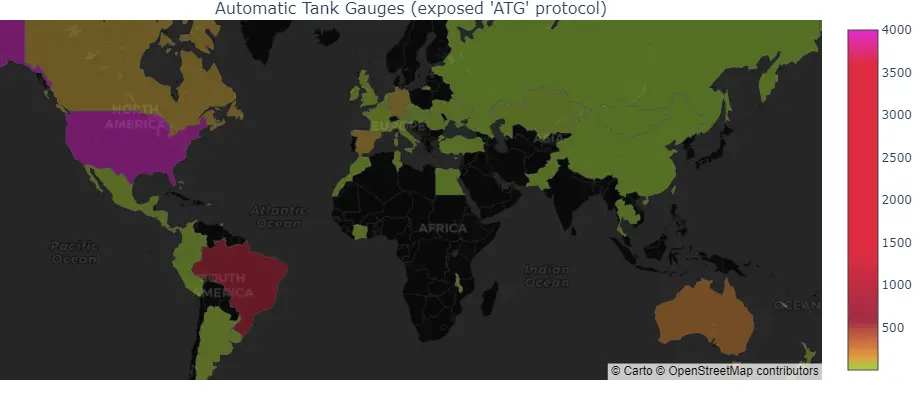
Image: Bitsight
In a recent revelation, security researchers at Bitsight have uncovered severe vulnerabilities within Automated Tank Gauge (ATG) systems—integral components used to monitor fuel levels in storage tanks across critical facilities worldwide. These flaws jeopardize the integrity of fuel supplies at gas stations, airports, and military bases and pose significant risks of environmental disasters and data breaches.
ATG systems are designed to meticulously track fuel levels, preventing overflows and ensuring seamless operations at facilities where fuel is indispensable. However, the newly identified vulnerabilities grant malicious actors unfettered access to these systems, enabling them to manipulate operations and potentially trigger catastrophic events.
Despite prior warnings, thousands of ATGs remain connected to the internet, rendering them easy targets for cyberattacks. According to Umbelino, in collaboration with the U.S. Cybersecurity and Infrastructure Security Agency (CISA) and manufacturers, eleven vulnerabilities were unearthed across six different ATG systems. Some companies have already issued updates, yet others ignore the problem, thereby endangering lives. The findings are as follows:
| PRODUCT | VULNERABILITY TYPE | CVE | CVSS 3.1 |
|---|---|---|---|
| Maglink LX | OS Command Injection | CVE-2024-45066 | 10.0 |
| Maglink LX | OS Command Injection | CVE-2024-43693 | 10.0 |
| Maglink LX4 | Hardcoded credentials | CVE-2024-43423 | 9.8 |
| OPW SiteSentinel | Authentication Bypass | CVE-2024-8310 | 9.8 |
| Proteus® OEL8000 | Authentication Bypass | CVE-2024-6981 | 9.8 |
| Maglink LX | Authentication Bypass | CVE-2024-43692 | 9.8 |
| Alisonic Sibylla | SQL Injection | CVE-2024-8630 | 9.4 |
| Maglink LX | XSS | CVE-2024-41725 | 8.8 |
| Maglink LX4 | Privilege Escalation | CVE-2024-45373 | 8.8 |
| Franklin TS-550 | Arbitrary File Read | CVE-2024-8497 | 7.5 |
Umbelino emphasizes that even after patches are applied, devices must be disconnected from the public internet. The majority of ATGs were not originally designed for network connectivity, which has led to these vulnerabilities. Physical disconnection from the internet is the sole reliable solution, the expert asserts.
ATG vulnerabilities empower attackers not only to manipulate operational processes on-site but also to cause serious accidents. For instance, altering the maximum capacity parameter of a tank or disabling alarms could result in uncontrolled fuel spillage. Other scenarios include equipment damage, confidential information leakage, or system functionality disruption.
Automated Tank Gauge systems are often interconnected with other vital components, such as sirens and ventilation systems. Control over these elements opens avenues for large-scale attacks with potentially catastrophic consequences.
The threat to critical infrastructure continues to escalate, especially amid assaults by state-sponsored hackers. In recent years, such cyberattacks on essential systems have markedly increased, and ATGs may become the next target for adversaries.
Related Posts:
- AI Powers a Phishing Frenzy – Zscaler Report Warns of Unprecedented Threat Wave
- Volexity: Indian APT hacker organization Patchwork target US think tanks
- Apache ActiveMQ Remote Code Execution Vulnerability
- The fish tank became a medium for hacker attacks